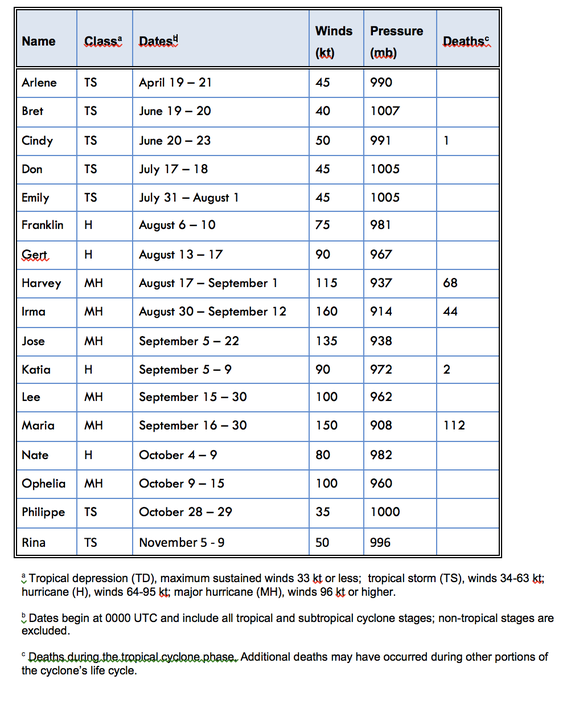Hurricanes will never be named Harvey, Irma, or Maria again

Hurricanes Harvey, Irma, Maria, and Nate were so destructive, no other hurricanes will be given the same names.
The World Meteorological Organization announced Thursday that it's retiring the names Harvey, Irma, Maria, and Nate from its rotation because of 2017's devastating season. It's replacing the names with Harold, Idalia, Margot, and Nigel instead.
SEE ALSO: Shell knew truth of global warming in 1980s; foresaw a Hurricane Sandy scenario
WMO names each hurricane based on an alphabetical rotation of names, alternating between male and female names. The selection of names for each rotation is usually used every six years, so we won't see Harold, Idalia, Margot, and Nigel come into use until 2023. If a hurricane is especially fatal and causes significant damage, its name is taken off the rotation and replaced with a different one.
According to the WMO's FAQ, this naming system makes it easier for news outlets to report on the storms and increases community preparedness.
"Experience shows that the use of short, distinctive given names in written as well as spoken communications is quicker and less subject to error than the older more cumbersome latitude-longitude identification methods," WMO's FAQ says.
WMO says that the 2017 hurricane season was "one of the most destructive on record," with damages in the United States alone costing $250 billion.

Image: world METEOROLOGICAL organization
The hurricanes taken off the WMO's rotation of names caused 224 deaths during their tropical cyclone phases.
Hurricanes Harvey, Irma, and Maria were the first Category 4 storms to make landfall in the United States on record. Irma and Maria both reached Category 5 storms when they made landfall on the Caribbean islands. The damage caused in the Caribbean is likely to take years to recover, according to WMO.
#Harvey in perspective. So much rain has fallen, we've had to update the color charts on our graphics in order to effectively map it. pic.twitter.com/Su7x2K1uuz
— NWS (@NWS) August 28, 2017
Seventeen tropical storms were named in 2017, and 10 of those storms became hurricanes. Six reached "major hurricane strength" and clocked in at Category 3 or higher. This is above the average for annual storms; from 1981-2010, the average was 12 tropical storms, six hurricanes, and three major hurricanes.
Harvey made landfall over or near Texas last August as a Category 4 hurricane. It lasted for four days, devastating Houston and causing the deaths of 68 people. It was the costliest hurricane after Katrina, causing an estimated $125 billion in damages.
Irma caused significant destruction in the Caribbean as a Category 5 hurricane, nearly wiping out Barbuda. It was the first hurricane to make landfall in Cuba since 1932, and it prompted the evacuation of about 6 million people in southern Florida.
Satellite view of Hurricane #Maria as it hammered Puerto Rico with powerful winds, storm surge & extreme rainfall: https://t.co/JdGdW2fs8m pic.twitter.com/hU61NJqmdB
— NASA (@NASA) September 21, 2017
Maria ripped through Dominica and Puerto Rico in September. Dominica's damages are estimated at $1.3 billion, or about 224 percent of its GDP according to WMO. The entire island of Puerto Rico lost power, which one report concluded was the second largest blackout in history.
Nate crossed from Nicaragua to Honduras as a tropical storm, but made landfall as a category 1 hurricane. The rainfall from Nate caused 44 deaths in Central America.
2017 retired almost as many names as 2005, when the severe hurricane season resulted in WMO removing Dennis, Katrina, Rita, Stan, and Wilma from the rotation.
WATCH: These emergency igloo shelters are helping homeless people in France survive freezing temperatures


